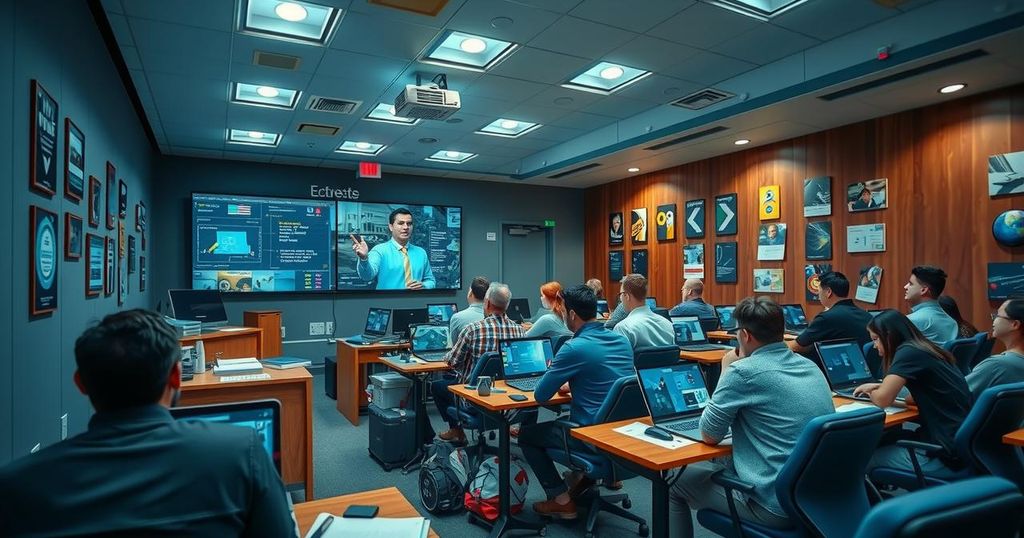Revolutionizing Education: The Impact of AV Technology in Classrooms
In higher education, 4K visual displays are revolutionizing learning, creating immersive experiences that capture student engagement. A survey shows strong support for increased technology use in classrooms, with Panasonic leading by expanding its AV solutions. Their innovative products, like advanced projectors and ceiling microphones, are tailored to meet hybrid learning demands. This transformation not only improves educational delivery but also enhances university appeal to prospective students, marking a significant evolution in how knowledge is imparted and received.
In the ever-evolving landscape of higher education, the adoption of 4K visual displays is transforming learning environments into captivating, sensory wonderlands. These high-tech tools create immersive experiences that engage students like never before. A recent survey revealed that two-thirds of instructors expect increased technological integration in classrooms over the next three years, underlining the critical role of audio-visual (AV) technology in driving student engagement and enhancing educational experiences. Imagine sitting in an art history class, enveloped by 360° projections of Picasso’s masterpieces, a truly immersive way to absorb knowledge.
Panasonic Connect is at the forefront of this AV revolution, recently announcing the expansion of its AV Solution Suite at InfoComm 2024. With the aim of fostering engaging visual experiences, Panasonic is keen on providing reliable, flexible solutions tailored for various industries, including education. Jared Darensbourg, director of sales for Visual Systems at Panasonic Connect, emphasizes that as immersive experiences become a necessity, the technology used needs to be both dependable and user-friendly, allowing educators to focus on exciting content delivery rather than technical difficulties.
For nearly half a century, Panasonic’s commercial audio-visual division has dominated the educational space, supplying high-end projectors and cameras specifically designed for complex classroom environments. Their innovative PTZ cameras, equipped with robotic features that enhance image capture without distortion, are now complemented by the latest ceiling microphones. According to Petro Shimonishi, director of product management, these microphones were developed in collaboration with 80 universities, gathering critical feedback to innovate their design, ultimately enhancing audio clarity in educational settings.
Post-Covid, the demand for advanced AV technology has skyrocketed, particularly as hybrid learning remains a mainstay in education. Students now expect to participate in classes from diverse locations, including outdoor spaces, seamlessly connecting to their courses via high-quality audio-visual setups. Panasonic’s solutions adapt to this new norm, automatically centering on educators as they move around the classroom, ensuring that both in-person and remote students remain engaged.
The demand for upgraded technology in classrooms doesn’t merely serve instructional purposes; it also aids in student recruitment. Potential students and their parents are increasingly concerned about the educational infrastructure, particularly the technological capabilities of a college. Having advanced AV systems is a strong selling point for universities, showcasing a commitment to high-quality education. Panasonic’s live production platform, for instance, facilitates seamless content delivery, enriching the overall educational experience.
Panasonic’s latest offerings include innovative projectors and media production tools that enhance presentations and streamline workflows. The compact 4K projectors, designed for classroom installation, offer unmatched performance without taking up excessive space, ensuring they complement existing AV setups. This continuous evolution in educational technology represents not just a response to changing demands but a proactive step towards creating engaging and flexible learning environments that cater to every student’s needs.
As technology advances, so too does its role in shaping educational experiences. The growing integration of high-end audio-visual tools in higher education is crucial for enhancing student engagement and accommodating various learning styles. The shift towards hybrid learning models post-COVID has accelerated the need for reliable AV solutions, prompting companies like Panasonic to innovate and cater specifically to the higher education sector. Their efforts reflect an awareness of the changing pedagogical landscape and an understanding of the importance of accessible, immersive learning environments. Surveys indicate that educators recognize the value of technology in the classroom, further emphasizing the demand for tools that not only facilitate teaching but also create more interactive and engaging experiences for students.
The transformation of higher education through advanced audio-visual technologies represents a profound shift in teaching and learning methodologies. Companies like Panasonic Connect are driving this change, ensuring that classrooms evolve into immersive environments that captivate students. As educational paradigms shift towards a hybrid model, the ability to provide high-quality audio-visual experiences will not only enhance engagement but also serve as a vital tool for recruitment. Ultimately, the future of education lies in leveraging technology to foster creativity and inspire a new generation of learners.
Original Source: www.technewsworld.com




Post Comment